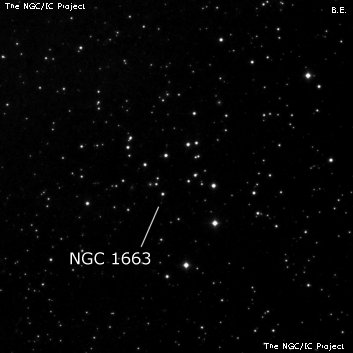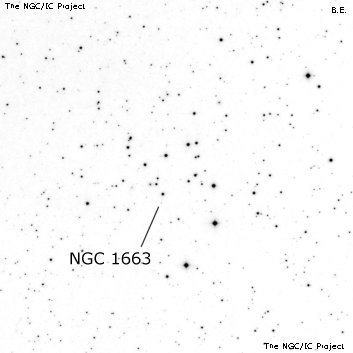NGC/IC Project Restoration Effort
(This is a very very beta version)
NGC1663


Basic Information
Location and Magnitude
Right Ascension: 4:49:24.3
Declination: +13:8:27
Constellation: ORI
Visual Magnitude: 14.5
Historic Information
Discoverer: Herschel W.
Year of discovery: 1784
Discovery aperture: 18.7
Observational
Summary description: Cl, lRi, st L ___DREYER___ S
Sub-type: IV2p
Corwin's Notes
=====
NGC 1663 is probably the poor, scattered cluster about 45 seconds of time
following WH's single position. This is one of his earlier objects (10 Feb
1784), so the position problem -- if it is one -- may be understandable as
part of his learning curve. His description "A cluster of large and small
scattered stars, not rich" certainly fits. There are about two dozen stars
scattered over an area 12 arcmin by 10 arcmin with a 4 arcmin by 4 arcmin core
containing half the stars.
WH's position itself sits in a void surrounded by a weak annulus half a degree
across of scattered stars, strongest on the following side (where the cluster
noted in the previous paragraph sits). Is this the object that WH actually
saw? If so, I suspect that he would have noted the annular structure.
My best guess is the cluster following his position. Visual verification
would not go amiss.
Steve's Notes
=====
NGC 1663
17.5" (2/3/03): at 140x, ~20 stars are resolved in a scattered 6'-7' group. Includes a shallow arc of three brighter mag 10 stars on the SW side which may not be cluster members. Most of the mag 12-13 stars are concentrated in a 3' subgroup on the north side. Stands out reasonably well in the field although this group has been listed as a "possible open cluster remnant" - Bica et al., 2001A&A...366..827B. The Lynga position, DSFG, NGC 2000, SC 2000 and RNGC all place the cluster too far west by ~45 tsec of RA.



